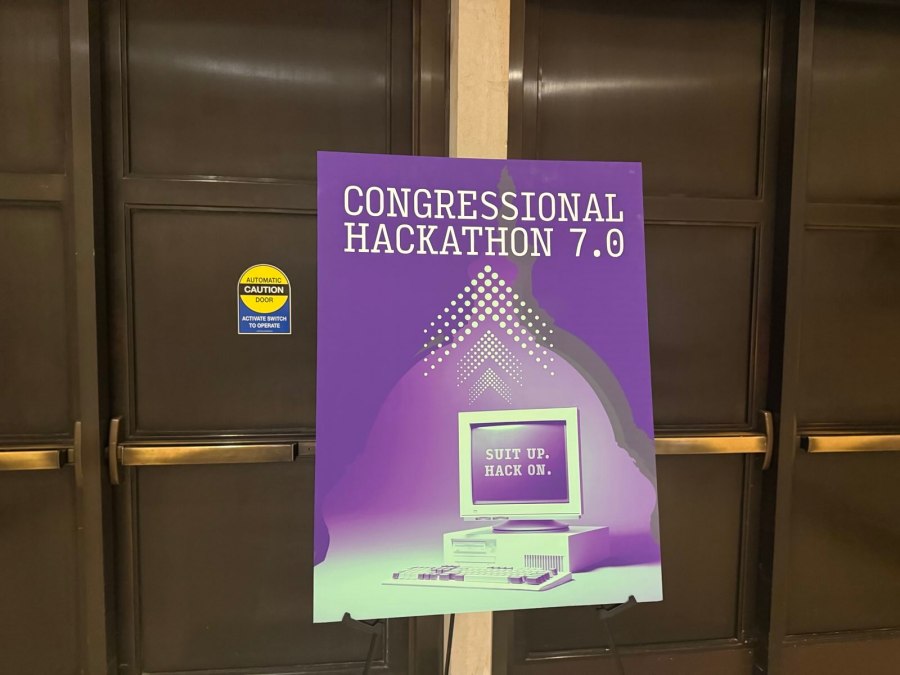Congressional Hackathon signals mentality shift over emerging tech

As the federal government increasingly adopts new technology to streamline workflows and services, congressional staffers and civic-tech figures are making clear they plan not just to keep pace, but help lead the way.
Technologists, policymakers, civil society groups and staffers from both chambers of Congress convened at the U.S. Capitol this week for the seventh Congressional Hackathon. Participants at the event made one message clear: the country’s legislative branch can’t afford to wait on emerging technology — and several civic technologists are already aiding this mission.
“This year’s hackathon did not come at a more important time,” House Speaker Mike Johnson, R-La., said in his opening remarks for Wednesday’s event. “I think all of you recognize that as the pace of technology ticks up with every year, the government has honestly been slow to keep pace.
“In some respects, we’ve been crawling behind where industry has sprinted forward,” Johnson added. “Too often, the government operates on a 10-, 20- or 30-year lag when it comes to embracing the technology of today.”
Congress has been criticized at times for its slow integration of newer technology for employees, members, and its constituents. However, observers closely following developments say the tides could be shifting.
“No matter which side of the aisle you’re on, the inclination for staff and for members is to stick with the status quo until we know everything about a potential shift and a potential change,” J.D. Rackey, an associate director with the Bipartisan Policy Center’s Structural Democracy Project, told FedScoop ahead of the event.
“There’s a hesitancy to embrace new technology because they don’t know how it’s going to work, or if adopting it would mess up some other system,” he added. “I do think since we’re in now year six or seven [that] the House has been working on modernization, there has been a slow cultural shift among both institutional staff and personal office saying, ‘Well, why do we need to keep doing this this way?’”
While the broader Washington community is increasingly focused on modernization this year, organizers behind the hackathon emphasized that this has been a mission for the event since its inception in 2011.
Steve Dwyer, senior director for innovation at the House Office of the Chief Administrative Officer, said energy around tech modernization has “been building for years,” partly thanks to the hackathon and the Committee on House Administration.
In its seventh year, the Congressional Hackathon enabled tech leaders, both within and outside of Congress, to brainstorm ideas on how technology can enhance efficiency for lawmakers and their constituents.
For the first time this year, the event also hosted a coding session, where dozens of computer programmers worked on building specific tools for Congress in just one day.
AI for Capitol Hill
Wednesday’s sessions — from remarks to lightning rounds to brainstorming sessions — touched upon several technology topics, but artificial intelligence was the buzzword of the day.
“I really believe that since [AI] is not going away, we’ve got to be doing everything we can to make it work for us and manage it,” said Sen. Mike Rounds, R-S.D., who is the first senator ever to address the hackathon. “If we don’t do that, somebody else is going to. So the fact that you’re here, the fact that you’re working on it and so forth, is telling me that we’re moving in the right direction.”
The heavy emphasis on AI was primarily evident in the lightning round presentations, where more than a dozen individuals — including high schoolers and college students — pitched their ideas or working projects on how technology can address congressional problems.
Jon Kokot, the founder and CEO of the AI platform Civic, was among the presenters, showing the company’s new product, Revere. The platform uses AI for the management of constituent communications and offers email batching, casework tracking, targeted constituent messages, constituent profile management and interactive maps to track sentiments. It can also create content specific to a member’s voice with the help of office data.
“We’ve talked with over 100 Hill staff and learned that today’s systems are outdated, slow and lack features for the whole office,” Kokot said. “Meanwhile, corporations, lobbyists and constituents are using AI and overwhelming offices with correspondence. The playing field is not level and if the status quo holds, things will only get worse.”
Kokot said Civic Revere is akin to having three additional employees in a House or Senate office. The product is awaiting approval from the Chief Administrative Officer.
Reflecting on the event later, Kokot told FedScoop the event was “proof” Congress is focused on reducing inefficiency, contrary to the public’s past perceptions.
In another presentation, audience members heard from Zach Johnson, a legislative assistant for Rep. Henry Cuellar, D-Texas, who explained how staffers can use existing AI technology to learn other platforms.
“If you lack a hard skill or competency in a certain software, you’re basically locked out of using that software, right?” Johnson said. “And so that’s where AI for experiential teaching comes in. Now this isn’t anything special, no fancy extra software required. This is as simple as saying, ‘I want to learn X platform, X software, X coding language. Can you teach me how to do this? Here’s the outcome I want. How can we reach it together?’”
He showed the audience how he asked OpenAI’s ChatGPT questions on how to write a Python script for a project on trade data in his office.
“Don’t be afraid to dip your toe in the water of software you’re new to, because AI can teach you how to use it along the way, and you’ll learn a lot more out of it than otherwise,” he said.
His comments came on the heels of Johnson’s announcement that House staffers will soon have access to Microsoft’s Copilot AI chatbot. The CAO later said it is reviewing the $1 deals other technology companies like Anthropic and Google made with the General Services Administration.
Technology for constituents
Improving front-facing technology for constituents was another central theme of Wednesday’s event.
“There is an emerging bipartisan consensus that how government writ large uses technology, both internally and how it interacts with the public, has been deficient for a while,” Rackey said.
Multiple technologists came up with ideas on how to fix that, including Aubrey Ottenstein, a former Hill staffer who went on to found Hilltop, a civic engagement platform giving constituents a “direct line” to their elected officials. The company rolled out the AI-powered platform CivIQ, which enables individuals to send personalized messages to their lawmakers, automatically batching them in the members’ office systems.
The product eliminates the need for phone calls and manual system processing, freeing up staff — especially office interns — to focus on other worthwhile tasks.
“We’re trying to make civic engagement and participation in the democratic process as frictionless as sending a text,” Ottenstein told FedScoop in a sideline interview. “Whether English is your first language or your second language, or if you maybe have called Capitol Hill 300 times, or you’ve never spoken to a member of Congress, we want it to be seamless and to have … our constituents feel empowered to send actionable messages that are tied to real legislation.”
Other presentations included AI-powered products to increase constituents’ access to legislative data, help them better understand bills under consideration and increase engagement with the use of AI chatbots.
Celebrating recent wins
While much of the event was brainstorming new ideas to modernize Congress, the hackathon also provided a stage for bodies like the CAO and House Digital Service to showcase the technology rolled out over the past year.
This included the internal rollout of Legidex, an internal digital House staff directory developed by the House Subcommittee on Modernization and Innovation alongside the House Digital Service. Previously, congressional offices often paid thousands of dollars for third-party directories, which do not always contain the most up-to-date information.
“Every single night, we’re pulling from the House payroll, the House active directory, even the badge system, everything. So it’s much more up to date and it has a really easy single sign-on for every staffer, and they can just edit anyone in their office,” Dwyer said, calling it a “smashing success.”
Another win for the CAO’s team was this year’s piloting of CaseCompass, a tool enabling Congress to analyze casework data across member offices. The tool helps staff identify trends and systemic issues among constituents, including tracking which federal agencies are most frequently the subject of constituent calls to member offices.
“Members don’t share casework information and there’s no systematic way to share that information and figure out, ‘Hey, is what we’re seeing a trend, or is this just a localized issue?’ Because you’re going to act differently to actually address that problem,” said Anne Meeker, the managing director of the nonprofit POPVOX Foundation.
Meeker, a former caseworker herself, testified before Congress on this issue in 2022.
Ananda Bhatia, a product manager for the House Digital Service, explained to FedScoop that the project originated from a breakout group session at last year’s hackathon.
“A lot of the folks showed up and talked about the difficulty that constituents have with understanding where to go when they have an issue with a federal agency and the challenges that staff have when they’re new and trying to learn district staff services,” Bhatia said.
Event organizers and observers in the space said they hope the process and products like these can inspire the broader push for modernization across the government.
“The hackathon and congressional modernization writ large is a kind of a leader in this space, and maybe can model how the rest of the federal government might start thinking about using technology in the 21st-century wave,” Rackey said.






